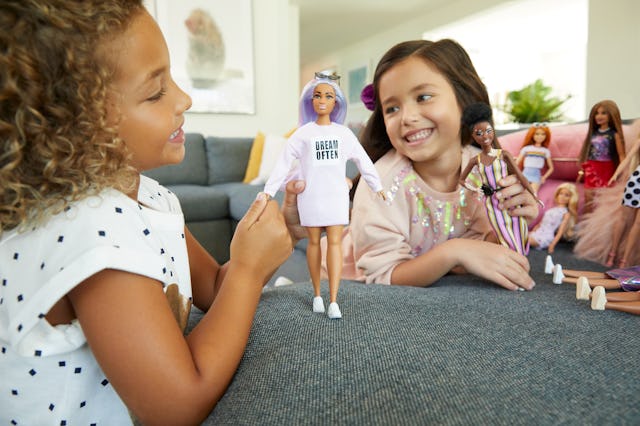6 Ways Dolls Can Help Kids Develop Empathy When They’re Learning From Home

Post written in partnership with Barbie®
It’s safe to say the first day of school looked a little different this year. Ok, it looked a lot different. For some kids, this year has felt like one giant time out. And, as their moms, we don’t like it any more than they do.
Many parents, right now, are concerned about the effect of social distancing on their child’s social and emotional development. When kids aren’t in the classroom or running around the playground at recess making new friends, many parents wonder if their children will fall behind in developing key skills like empathy.
But there’s a lot of room for optimism when it comes to our children, playtime and empathy. According to findings from a recent study by Cardiff University in collaboration with Barbie®, doll play activates brain regions that allow children to develop social processing skills like empathy, even when they’re playing by themselves. This is encouraging. Imaginative play with dolls comes particularly easily to kids — whether they’re cooped up at home due to social distancing or not.
With a little encouragement and guidance – and a few dolls – you can help your kids develop and practice skills that will become even more important as they get older and emotions become more complex. Here are a few ideas on how to teach empathy by incorporating doll play as a useful tool, even during these not-at-all-normal times.
Broaden Their Horizons
It’s human nature to empathize more easily with people “like us.” So something as simple as making sure your child’s dolls represent people who look different from the people in your own house can have an impact on their understanding of the world. It helps them begin to understand different perspectives – an important building block for developing kindness toward others. Offer your child a variety of dolls with different skin tones, genders, and abilities. While they play, help your child notice or imagine the things they have in common rather than the ways they’re different.
Create a Kindness Box
An easy way to encourage kindness in your family is to start a “kindness box.” Decorate a small-ish box – a shoe box is perfect – and cut a slit in the top. Encourage your kids to “catch” others participating in acts of kindness. Your child may focus on family members or include others you encounter throughout the day. The “kindness finder” then draws or writes the kindness they saw, along with the person’s name or a description (“the lady at the grocery store”), and slips it into the box. This kind of activity serves two purposes: it helps kids recognize unselfish behavior and shows them that your family values kindness toward others.
Name It, Don’t Shame It
Playing with dolls is an excellent opportunity to help your kids learn to name and talk about their feelings. When kids don’t have a way to identify their feelings, they can be harder to manage because it’s difficult to accept something we don’t understand. And for some kids, feelings can begin to feel shameful; something to push down or avoid.
Help your child develop their “feeling vocabulary” when playing with dolls like Barbie. Offer a scenario like “She isn’t able to sit with her friends at lunch. How do you think she feels?” Encouraging children to recognize what others might be feeling helps them become better able to talk about and accept their own feelings.
Encourage Free Play
Guiding our kids as they talk through different feelings and points of view is important. But it may be just as important to let them play on their own. Children often talk while playing on their own with dolls. When you listen, you get a window into their inner lives; you hear about their interests, worries and concerns. Free play also lets kids be, well, free to safely explore their own feelings and ideas without being directed by adults.
Let Them Care
Kids learn how to empathize through active practice. Look for age-appropriate opportunities for them to demonstrate care and kindness. Maybe that means helping care for the family pet or calling an older relative or delivering cookies to a neighbor. Another way to practice is to act out caring with dolls. A doctor doll can check on her patients. A teacher doll can help keep his students safe. The more kids practice kindness during play the more they’ll practice in real life.
Show Them You Value Imaginative Play
As parents, when we think about what kinds of toys and games help kids learn, we most often default to something with a STEM focus, right? Something with a clearly defined problem and solution where there is a “right” way. We don’t always think of playing with dolls as being educational. But this new research by Barbie in collaboration with Cardiff University challenges that perception.
In order for kids to be successful in the world, they have to develop resilience, compassion and empathy. They have to learn how to understand the perspectives of others. And playing with dolls, like Barbie, is an ideal way to explore those concepts.
We’ve seen the effects of a growing lack of empathy towards others in recent years. It’s encouraging to think there might be a way to help our children practice being empathetic towards others, even when they’re not able to be with friends and teachers.
Barbie® has always believed there are many benefits of playing with dolls, and now there is scientific evidence that supports it. Learn more about the neuroscience behind the benefits of doll play.
*Study was commissioned by Barbie (2020). Study was conducted with 42 children (20 boys and 22 girls) ages 4-8 years old with full data captured from 33 children.